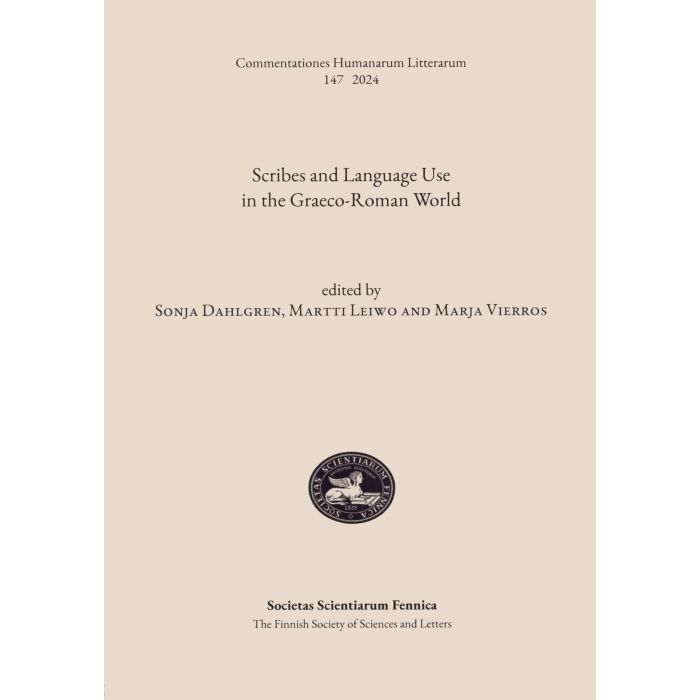Vi använder cookies för att göra din upplevelse bättre. För att följa det nya direktivet om e-integritet, behöver vi be om ditt medgivande att sätta cookies. Läs mer.
Scribes and Language Use in the Graeco-Roman World
Special Price
28,00 €
Normalt pris
35,00 €
I lager
SKU
978-951-653-520-6
Scribes and Language Use in the Graeco-Roman World
Ed. Sonja Dahlgren, Martti Leiwo and Marja Vierros
Finska Vetenskaps-Societeten - Suomen Tiedeseura
Commentationes Humanarum Litterarum 147
Vaasa 2024, 285 pp.
Ed. Sonja Dahlgren, Martti Leiwo and Marja Vierros
Finska Vetenskaps-Societeten - Suomen Tiedeseura
Commentationes Humanarum Litterarum 147
Vaasa 2024, 285 pp.
This volume examines the interface between individuals who plan and compose various documentary texts and the language used in those texts by analysing the complex processes of document creation and finalisation. It highlights the importance of variation across multiple linguistic dimensions—such as language choice, script, orthography, syntax, and document format—demonstrating how these factors interact to convey different social and functional meanings in nonliterary writing.
The contributors focus particularly on scribes and their influence on the linguistic outcomes of documentary texts: What kind of language is written, and why? Who authored the text, and who physically wrote it? It is argued that research on the language of ancient and medieval non-literary texts must consider the scribal level alongside the edited text. By ‘scribal level’, we refer to (1) the design of the text itself and (2) its actual writing, i.e. the practical skills involved in a specific context. This approach also considers the choice of language and writing system, as the scribe’s linguistic competence could significantly influence language selection. In addition to detailed linguistic analyses, an important outcome of this volume is its exploration of the varied ways in which the term ‘scribe’ is and can be used. A scribe might be an official tasked with writing documents according to authoritative requirements or someone who records a document or letter based on another’s dictation—whether a professional scribe, a semi-literate individual, or a member of the same household. Thus, a scribe could encompass anyone who records information. Here, the term ‘scribe’ is not restricted to writers of highstatus texts but includes a broader spectrum. Most contributors pay special attention to papyri and ostraka from Egypt due to their importance as source material, although other contexts are also considered. The data include the language use of notaries in the acts of the Council of Chalcedon and Late Latin charters from Tuscany. Cross-cultural effects on language use play a prominent role, especially the transfer of linguistic elements and scribal practices between languages. Greek papyri from Egypt exhibit significant variation. Some variants are classified by modern editors as nonstandard, substandard, or even mistakes. Consequently, editors often ‘regularise’ these deviations to conform to a ‘standard’ Greek or Latin.1 However, both languages underwent considerable change between the third century BCE and the seventh century CE.
The contributors focus particularly on scribes and their influence on the linguistic outcomes of documentary texts: What kind of language is written, and why? Who authored the text, and who physically wrote it? It is argued that research on the language of ancient and medieval non-literary texts must consider the scribal level alongside the edited text. By ‘scribal level’, we refer to (1) the design of the text itself and (2) its actual writing, i.e. the practical skills involved in a specific context. This approach also considers the choice of language and writing system, as the scribe’s linguistic competence could significantly influence language selection. In addition to detailed linguistic analyses, an important outcome of this volume is its exploration of the varied ways in which the term ‘scribe’ is and can be used. A scribe might be an official tasked with writing documents according to authoritative requirements or someone who records a document or letter based on another’s dictation—whether a professional scribe, a semi-literate individual, or a member of the same household. Thus, a scribe could encompass anyone who records information. Here, the term ‘scribe’ is not restricted to writers of highstatus texts but includes a broader spectrum. Most contributors pay special attention to papyri and ostraka from Egypt due to their importance as source material, although other contexts are also considered. The data include the language use of notaries in the acts of the Council of Chalcedon and Late Latin charters from Tuscany. Cross-cultural effects on language use play a prominent role, especially the transfer of linguistic elements and scribal practices between languages. Greek papyri from Egypt exhibit significant variation. Some variants are classified by modern editors as nonstandard, substandard, or even mistakes. Consequently, editors often ‘regularise’ these deviations to conform to a ‘standard’ Greek or Latin.1 However, both languages underwent considerable change between the third century BCE and the seventh century CE.
| Förläggare | Finska Vetenskaps-Societeten |
|---|---|
| ISBN | 978-951-653-520-6 |
| ISSN | 0069-6587 |
| Publikationsserie | Commentationes Humanarum Litterarum |
| Sarjanro | 147 |
| Tryckt (år) | 2024 |
| Publikationens omslag | Mjuk pärm |
| Bandtyp | Häftad |
| Språk | engelska |
| Vetenskapsgrenar | Antiikintutkimus, Språkforskning |


